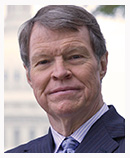President Obama has announced Judge Merrick Garland, chief judge for the U.S. Court of Appeals for the D.C. Circuit, as his Supreme Court nominee to replace the recently deceased conservative icon Justice Antonin Scalia. The president praised Garland for “his decency, modesty, integrity, even-handedness and excellence” and as a consensus builder.
What the president was subtly alluding to in his carefully worded statement is that Garland is a moderate liberal, not an ideologue, and thus hinting at the possibility that Garland just might be a liberal “swing vote.” That’s a justice who occasionally crosses over to vote with the opposing ideological side.
Don’t hold your breath. In recent decades, it seems only Republican Supreme Court picks become swing votes; liberals hold fast to their liberalism.
When President Bill Clinton nominated Ruth Bader Ginsburg to the Court, the president and the media praised her for being moderate and fair. Ditto for Obama’s two previous Supreme Court nominees, Sonia Sotomayor and Elena Kagan. Those three, along with Stephen Breyer, also a Clinton appointee, make up the Court’s liberal wing.
On issues where conservatives and liberals divide along ideological lines, the Court’s liberals vote their liberalism. Not one of them is considered a swing vote.
Take, for example, the 2012 vote on whether the federal government could require citizens to buy health insurance. No one seriously believed any of the four liberals would oppose the mandate. All of the discussion was whether the current swing vote, Anthony Kennedy, a Reagan appointee, or perhaps Chief Justice John Roberts, a George W. Bush appointee, would vote with the liberals.
Roberts did in 2012, and both Roberts and Kennedy voted with the liberals in a follow-up Obamacare decision in 2015.
Everyone knew the liberals would march in lockstep.
Prior to Kennedy, Sandra Day O’Connor, another Reagan appointee, was the swing vote on the Rehnquist Court.
When Patrick D. Shushereba looked at the role of the Court’s swing votes from 1981 to the present, there were only two associate justices who fit the description over a 35-year period: O’Connor and Kennedy.
Of course, Justice David Souter, a George H.W. Bush appointee now retired, couldn’t really be called a swing vote—because he was a reliable liberal vote.
Prior to Kennedy and O’Connor there was Lewis Powell, a Nixon appointee. Powell was considered a moderate Democrat—they still had those then—and he arguably became a swing vote.
Oh, did I mention that Republican-appointee Powell joined the Court’s majority in upholding Roe v. Wade?
And then there was Potter Stewart, an Eisenhower appointee, who some consider the Court’s swing vote during part of his tenure.
Source” Merrill Matthews, http://rare.us
 Listen Online
Listen Online Watch Online
Watch Online Find a Station in Your Area
Find a Station in Your Area










 Listen Now
Listen Now Watch Online
Watch Online
